
(a)
Interpretation:
Among the given pair of compounds, which compound has the polar pi bond that will undergo nucleophilic addition more rapidly is to be identified and explained.
Concept introduction:
A Nucleophilic addition reaction involves a polar
Answer to Problem 17.34P
Among the given pair of compounds, the second compound has the polar pi bond that will undergo nucleophilic addition more rapidly than the first one. This is because with fewer alkyl groups attached to the carbonyl carbon, there is less bulkiness and greater concentration of positive charge.
Explanation of Solution
The given pair of compounds are
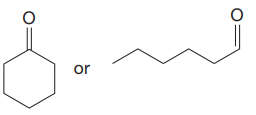
The electron-donating groups attached to the carbonyl carbon will decrease the concentration of the positive charge on the carbonyl carbon atom. In the first compound, the carbonyl carbon has two electron-donating substituents attached. In the second compound, the carbonyl carbon has only one electron-donating substituent attached. The partial positive charge on the carbonyl carbon of the second compound is greater as compared to the first one. This makes the carbonyl carbon of the second compound more electrophilic, thus, it will have more polar pi bond. Due to this, it will undergo nucleophilic addition reactions more rapidly. Due to fewer alkyl groups attached in the second compound, there is less bulkiness and hence greater contribution of a positive charge.
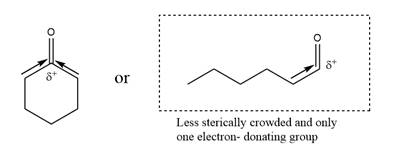
Electron-donating groups directly attached to the carbonyl carbon will decrease the concentration of a partial positive charge and make the pi bond less polar.
(b)
Interpretation:
Among the given pair of compounds, which compound has the polar pi bond that will undergo nucleophilic addition more rapidly is to be identified and explained.
Concept introduction:
A Nucleophilic addition reaction involves a polar
Answer to Problem 17.34P
Among the given pair of compounds, the second one has a more polar pi bond that will undergo nucleophilic addition more rapidly than the first one. This is because a substituent -
Explanation of Solution
The given pair of compounds are
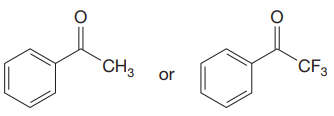
The electron-withdrawing groups attached to the carbonyl carbon will increase the concentration of the positive charge on the carbonyl carbon atom. In the first compound, the carbonyl carbon has a benzene ring at one end, and a
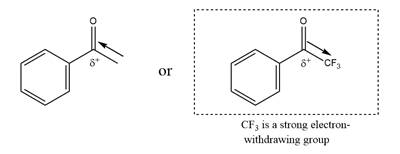
Electron-withdrawing groups directly attached to the carbonyl carbon will induce a greater concentration of a partial positive charge and make the pi bond more polar.
(c)
Interpretation:
Among the given pair of compounds, which compound has the polar pi bond that will undergo nucleophilic addition more rapidly is to be identified and explained.
Concept introduction:
A Nucleophilic addition reaction involves a polar
The concentration of the positive charge on the carbonyl carbon increases as the distance between an electron-withdrawing atom or group and the carbonyl carbon decreases.
Answer to Problem 17.34P
Among the given pair of compounds, the first one has more polar pi bond that will undergo nucleophilic addition more rapidly than the second one. This is because with the chlorine atom closer to the carbonyl carbon, the carbonyl carbon will bear a greater concentration of positive charge.
Explanation of Solution
The given pair of compounds are
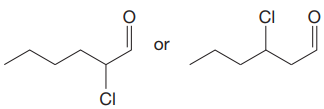
Among the given pair of compounds, the first one has more polar pi bond that will undergo nucleophilic addition more rapidly than the second one. This is because with the chlorine atom closer to the carbonyl carbon, the carbonyl carbon bears a greater concentration of positive charge. The partial positive charge on the carbonyl carbon of the first compound is greater as compared to the second one. This makes the carbonyl carbon of the first compound more electrophilic, thus, it will have more polar pi bond. Due to this, it will undergo nucleophilic addition reactions more rapidly.
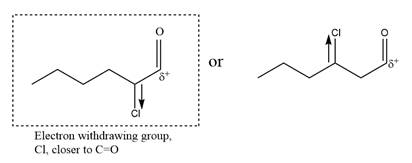
The concentration of the positive charge on the carbonyl carbon increases as the distance between an electron-withdrawing atom or group and the carbonyl carbon decreases.
(d)
Interpretation:
Among the given pair of compounds, which compound has the polar pi bond that will undergo nucleophilic addition more rapidly is to be identified and explained.
Concept introduction:
A Nucleophilic addition reaction involves a polar
Explanation of Solution
The given pair of compounds are:
![]()
Among the given pair of compounds, the first one has more polar pi bond that will undergo nucleophilic addition more rapidly than the second one. This is because the nitrile carbon bears a higher concentration of positive charge owing to the presence of the electron-withdrawing


Electron-withdrawing groups directly attached to the pi bond will induce a greater concentration of a partial positive charge and makes the pi bond more polar.
[DK1]
Want to see more full solutions like this?
Chapter 17 Solutions
Organic Chemistry: Principles And Mechanisms
- For questions 1-4, consider the following complexes: [Co(CN)6], [COC14]², [Cr(H2O)6]²+ 4. Room temperature (20°C) measurement of molar magnetic susceptibility (Xm) for Fe(NH4)2(SO4)2×6H2O is 1.1888 x 102 cgs (Gaussian units). Calculate effective magnetic moment and provide a number of unpaired electrons for the iron ion. Use this number to rationalize the coordination geometry around iron center. (4 points)arrow_forward7. Describe the expected 31P and 19F (where applicable) NMR spectral patterns for the following compounds (indicate number of signals and their splitting patterns). a) tetraphenyldiphosphine Ph Ph P-P Ph Ph Ph Ph ' b) tetraphenyldiphosphine monoxide P-P-Ph Ph (2 points) (2 points c) tetrafluorophosphonium hexafluorophosphate [PF4]*[PF6]¯ (4 points)arrow_forward3. For questions 1-4, consider the following complexes: [Co(CN)6]4, [COC14]², [Cr(H2O)6]²+ Which (if any) of these complexes would be expected to display Jahn-Teller distortion? (2 points)arrow_forward
- What is Instrumental Neutron Activation and what are the advantages and disadvantages in using its applications? (I'm doing an in class assignment and need better understanding of what the instrument can be used for) Please include references so that I can better understand the application of how the instrument works!arrow_forwardWhat is Isotope Analysis and what are the advantages and disadvantages in using its applications and instrumentalization? Please include references so that I can better understand how the instrument works!arrow_forward5. Count the electrons on the following complexes and state whether they follow the 18- electron rule: (3 points) Fe(CO)5 Ni(PMe3)4 PMe3 is trimethylphosphine Mn(CO)5Brarrow_forward
- For questions 1-4, consider the following complexes: [Co(CN)6]+, [CoCl4]², [Cr(H2O)6]²+ 2. Draw the corresponding d-orbital splitting for each of the complexes; predict the spin- state (low-spin/high spin) for each of the complexes (if applicable); explain your arguments. Calculate the crystal field stabilization energy for each complex (in Ao or At). (6 points)arrow_forwardFor questions 1-4, consider the following complexes: [Co(CN)6]4, [COC14]², [Cr(H2O)6]²+ 1. Assign oxidation number to the metal, then indicate d-electron count. (3 points)arrow_forwardUsing iodometry I want to titrate a sodium thiosulfate solution and I use 15 mL. If I have 50 mL of a 0.90 M copper solution and KI, what will be the molarity of sodium thiosulfate?arrow_forward
 Organic Chemistry: A Guided InquiryChemistryISBN:9780618974122Author:Andrei StraumanisPublisher:Cengage Learning
Organic Chemistry: A Guided InquiryChemistryISBN:9780618974122Author:Andrei StraumanisPublisher:Cengage Learning

